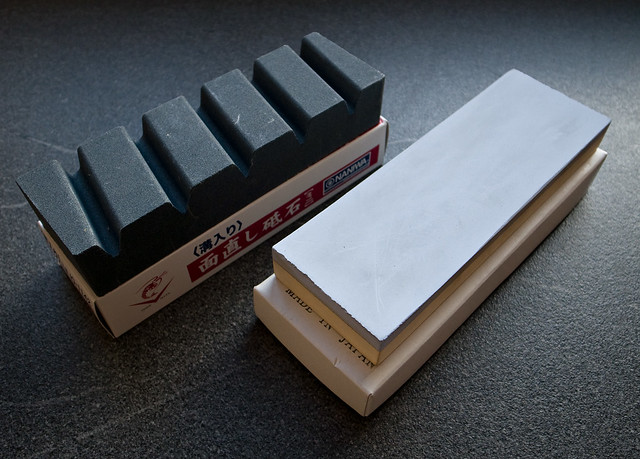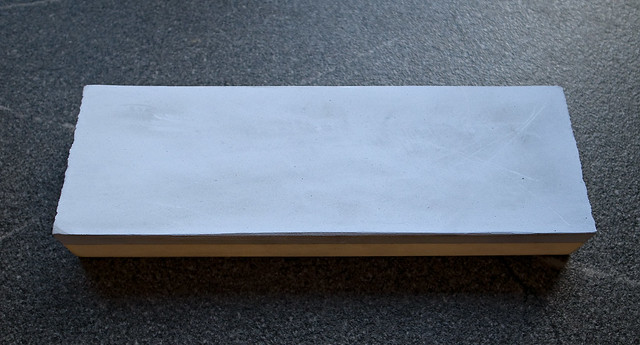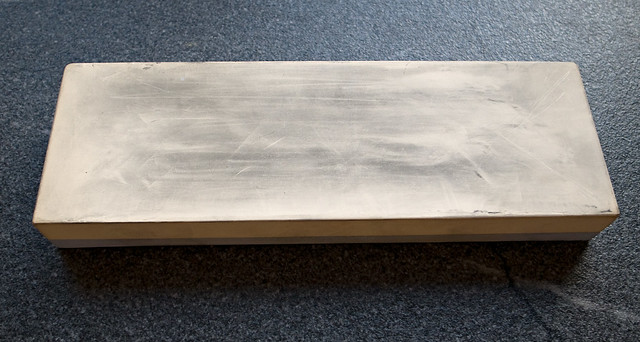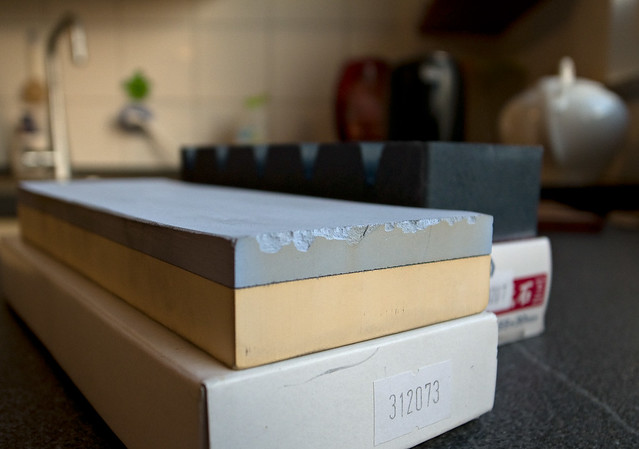Hello, this is my first 'review' here. Since I am not all that experienced please take what is written here with a bit of grain of salt.
But onto the topic. I have bought the CERAX 1000/6000 combination sharpening stone back in March 2013 to start learning how to 'properly' sharpen our kitchen knives - as I was about the dip my finger in the waters of japanese kitchen knives. My previous sharpening experience was limited to a dedicated (and somewhat cumbersome) sharpening system from KME.
The stone dimensions are: 182 x 62 x 27 mm, so a bit smaller than a 'full size' stone. The photos below show the stone after about 30 knives have been sharpened (many of them from truly dull state where a 400-600 stone would have been a better start) and you can see how the 1000 side (blue) is thinner than the 6000.
The stone needs about 5 - 10 minutes soaking time.
The 1000 side is relatively soft, not too fast cutting and dishes rather fast. I have flattened this side 3 times. I have used a Naniwa flattening stone (grit 220) and a sandpaper. I did chip the 1000 side on the edges as the stone does not seem to 'hold together' all too well. But I also have to admit that this stone was 'forced' to make work of a lower grit stone what of course speeded up the dishing. The 'feel' if the 1000 side is not particularly strong - the stone seems quite muddy, but I did not have the impression that the mud makes cutting faster. This side was also rather easy to gauge if not careful.
The 6000 side is much harder and feels very nice and smooth in the use. The speed it OK and it leaves a near mirror finish.
It may be interesting to mention that neither the 1000 nor the 6000 side seem to be the same material as the single grit Cerax stones so I would not use it as a gauge for other Cerax stones.
Al in all - probably not the best stone on the planet, but in spite of its shortcomings I did lear quite a lot (with great help from DVD from Murray Carter). I did manage to put a shaving or near-shaving edge on the better knives I have sharpened.
I have just recently ordered 400, 2000 and 6000 Gesshing stones (which I have yet to use - I know, a shame, but I do not want to hurry through my first session with them) and also thanks to this small Cerax I should have a good start towards using them effectively and correctly.
Now a few photos (follow the links for large photos):
The Cerax and the Naniwa flattening stone:

1000 side:

6000 side:

1000: chips after flattening (user error?)

But onto the topic. I have bought the CERAX 1000/6000 combination sharpening stone back in March 2013 to start learning how to 'properly' sharpen our kitchen knives - as I was about the dip my finger in the waters of japanese kitchen knives. My previous sharpening experience was limited to a dedicated (and somewhat cumbersome) sharpening system from KME.
The stone dimensions are: 182 x 62 x 27 mm, so a bit smaller than a 'full size' stone. The photos below show the stone after about 30 knives have been sharpened (many of them from truly dull state where a 400-600 stone would have been a better start) and you can see how the 1000 side (blue) is thinner than the 6000.
The stone needs about 5 - 10 minutes soaking time.
The 1000 side is relatively soft, not too fast cutting and dishes rather fast. I have flattened this side 3 times. I have used a Naniwa flattening stone (grit 220) and a sandpaper. I did chip the 1000 side on the edges as the stone does not seem to 'hold together' all too well. But I also have to admit that this stone was 'forced' to make work of a lower grit stone what of course speeded up the dishing. The 'feel' if the 1000 side is not particularly strong - the stone seems quite muddy, but I did not have the impression that the mud makes cutting faster. This side was also rather easy to gauge if not careful.
The 6000 side is much harder and feels very nice and smooth in the use. The speed it OK and it leaves a near mirror finish.
It may be interesting to mention that neither the 1000 nor the 6000 side seem to be the same material as the single grit Cerax stones so I would not use it as a gauge for other Cerax stones.
Al in all - probably not the best stone on the planet, but in spite of its shortcomings I did lear quite a lot (with great help from DVD from Murray Carter). I did manage to put a shaving or near-shaving edge on the better knives I have sharpened.
I have just recently ordered 400, 2000 and 6000 Gesshing stones (which I have yet to use - I know, a shame, but I do not want to hurry through my first session with them) and also thanks to this small Cerax I should have a good start towards using them effectively and correctly.
Now a few photos (follow the links for large photos):
The Cerax and the Naniwa flattening stone:

1000 side:

6000 side:

1000: chips after flattening (user error?)





